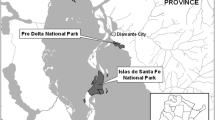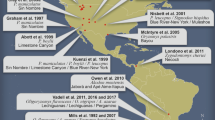Abstract
Dynamics of the reservoir potential (RP) and its index (IRP) in rodents inhabiting Primorskii krai and carriers of hantaviruses have been studied. The long-term annual average IRP in the genus Apodemus equals 0.83. In A. peninsulae, the IRP has turned out to be two times higher than that in A. agrarius (t = 2.636; n = 18; p = 0.017). The prognostic markers of a possible outbreak of epidemic disease caused by hantaviruses in Primorskii krai are discussed.
Similar content being viewed by others
References
Bernshtein, A.D., Apekina, N.S., Mikhailova, T.V., Myasnikov, Y.A., Khlyap, L.A., Korotkov, Y.S., and Gavrilovskaya, I.N., Dynamics of Puumala hantavirus infection in naturally infected bank voles (Cletrionomus glareolus), Arch. Virol., 1999, vol. 144, pp. 2415–2428.
Bernshtein, A.D., Apekina, N.S., and Tkachenko, E.A., Relationship peculiarities of hantavirus and the hosts and the infection manifestation of European hantavirus spots, Med. Virusol., 2009, vol. 26, pp. 153–155.
Gromov, I.M. and Erbaeva, M.A., Mlekopitayushchie fauny Rossii i sopredel’nykh territorii. Zaitseobraznye i gryzuny (Mammals of Russian Fauna and Adjacent Regions. Lagomorphs and Rodents), St. Petersburg, 1995.
Kallio, E.R., Klingstrum, J., Gustafsson, E., Manni, T., Vaheri, A., Henttonen, H., Vapalahti, O., and Lundkvist, A., Prolonged survival of Puumala hantavirus outside the host: evidence for indirect transmission via the environment, J. Gen. Virol., 2006, vol. 87, pp. 2127–2134.
Kosoy, M., Slonova, R., and Mills, J.N., Community structure and prevalence of hantavirus infection in rodents: a geographic division of the enzootic area in Far Eastern Russia, J. Vector Ecol., 1997, vol. 22, no. 1, pp. 52–63.
Kushnareva, T.V., Epizootologic potential of mouse-like rodents in natural nidi of hantavirus infection and its epidemiological significance, Pacific. Med. J., 2008, no. 2, pp. 50–52.
Kushnareva, T.V., Kompanets, G.G., Maksema, I.G., Iunikhina, O.V., and Slonova, R.A. Identification of hantaviruses—agents of hemorrhagic fever with renal syndrome in the secrets of naturally infected mice of genus Apodemus, Far-Eastern. J. Infect. Patol., 2008, no. 13, pp. 130–133.
Kushnareva, T.V., Slonova, R.A., Iunikhina, O.V., and Kushnarev, E.L., Hantaviruses in environment in natural nidi of hantavirus infection, Pacific. Med. J., 2010, no. 3, pp. 37–40.
Lakin, G.F., Biometriya (Biometry), Moscow: Vysshaya Shkola, 1990.
Lokugamage, K., Kariwa, H., Hayasaka, D., Cui, B.Z., Iwasaki, T., Lokugamage, N., Ivanov, L., Volkov, V., Demenev, V., Slonova, R., Kompanets, G., Kushnareva, T., Kurata, T., Maeda, K., Araki, K., Mizutani, T., Yoshimatsu, K., Arikawa, J., and Takashima, I., Genetic characterization of hantaviruses transmitted by the Korean field mouse (Apodemus peninsulae), Far East Russia, Emerg. Infect. Dis., 2002, vol. 8, no. 8, pp. 768–776.
Nafeev, A.A. and Shemyatikhina, G.B., Ecological and epidemiological approaches to the control of hemorrhagic fever with renal syndrome, Epidemiol. Infect. Dis., 2011, no. 1, pp. 49–50.
Novikov, G.A., Polevye issledovaniya po ekologii nazemnykh pozvonochnykh (Field Studies on Ecology of the Land Vertebrates), Moscow: Sov. Nauka, 1953.
Onishchenko, G.G., Distribution of virus natural infections in Russian Federation and their prevention measures, Epidemiol. Infect. Dis., 2000, no. 4, pp. 4–8.
Safronetz, S., Lindsay, R., Dibernardo, A., et al., A preliminary study of the patterns of Sin Nombre viral infection and shedding in naturally infected deer mice (Peromyscus maniculatus), Vector Borne Zoonotic Dis., 2005, vol. 5, no. 2, pp. 127–137.
Slonova, R.A., Kushnareva, T.V., Iunikhina, O.V., Kompanets, G.G., Maksema, I.G., and Kushnarev, E.L., Dynamics of identification of hantavirus in mouse eliminative organs of genus Apodemus and its relation with epidemic manifestation of hantavirus infection, Vopr. Virusol., 2010a, vol. 55, no. 2, pp. 38–42.
Slonova, R.A., Kushnareva, T.V., and Kompanets, G.G., Modern aspects of natural infection nidi of hantavirus infection in Primorye, Pacific. Med. J., 2008, no. 2, pp. 5–9.
Slonova, R.A., Kushnareva, T.V., and Kompanets, G.G., Modern view on natural focal hantavirus infection, Bull. Sib. Depart. Russ. Acad. Med. Scien, 2011, vol. 31, no. 4, pp. 13–19.
Slonova, R.A., Kushnareva, T.V., Kompanets, G.G., Maksema, I.G., Iunikhina, O.V., and Kushnarev, E.L., Relationship of epidemic of hantavirus infection with epizootic process in mice populations of genus Apodemus, Pacific. Med. J., 2010b, no. 3, pp. 34–37.
Slonova, R.A., Kushnareva, T.V., Kompanets, G.G., Maksema, I.G., Simonova, T.L., and Simonov, S.B., Hantavirus infection in Primorye — epidemiologic conditions in the nidi of circulation of different serotypes of virus, J. Epidemiol. Microbiol., 2006, no. 3, pp. 74–77.
Tarasov, M.A., Vainer, G.B., and Karavaeva, T.B., Complex assessment of epidemic conditions of a territory for hemorrhagic fever with renal syndrome, J. Microbiol. Epidemiol. Immunol., 2004, no. 6, pp. 22–26.
Ulrich, R.G., Schmidt-Chanasit, J., Schlegel, M., Jacob, J., Pelz, H.J., Mertens, M., Wenk, M., Buchner, T., Masur, D., Sevke, K., Groschup, M.H., Gerstengarbe, F.W., Pfeffer, M., Oehme, R., Wegener, W., Bemmann, M., Ohlmeyer, R., Wolf, R., Zoller, H., Koch, J., Brockmann, S., Heckel, G., and Essbauer, S.S., Network “rodent-borne pathogens” in Germany: longitudinal studies on the geographical distribution and prevalence of hantavirus infections, Parazitol. Res., 2008, vol. 103,suppl. 1, pp. 121–129.
Varshavskii, S.N. and Krylova, K.T., Osnovnye printsipy opredeleniya voazrasta myshevidnykh gryzunov. 1. Myshi. Fauna i ekologiya gryzunov (General Principles of Determination of Age of Mouse-Like Rodents. 1. Mice. Fauna and Ecology of Rodents), Moscow: Mosk. Gos. Univ., 1949, pp. 179–190.
Yashina, L.N., Ivanov, L.I., Slonova, R.A., Kompanets, G.G., Gutorov, V.V., Kushnareva, T.V., Vysochina, N.P., Abramov, S.A., Dupal, T.A., Pukhovskaya, N.M., and Zdanovskaya, N.I., Hantaviruses circulating in voles Microtus fortis and Microtus maximowiczii, Pacific. Med. J., 2008, no. 2, pp. 47–49.
Author information
Authors and Affiliations
Corresponding author
Additional information
Original Russian Text © T.V. Kushnareva, R.A. Slonova, 2014, published in Sibirskii Ekologicheskii Zhurnal, 2014, No. 1, pp. 27–34.
Rights and permissions
About this article
Cite this article
Kushnareva, T.V., Slonova, R.A. The natural host range of hantaviruses and their reservoir potential in the dynamics of the epizootic process within the ecosystems of Primorskii Krai. Contemp. Probl. Ecol. 7, 19–25 (2014). https://doi.org/10.1134/S1995425514010090
Received:
Published:
Issue Date:
DOI: https://doi.org/10.1134/S1995425514010090




